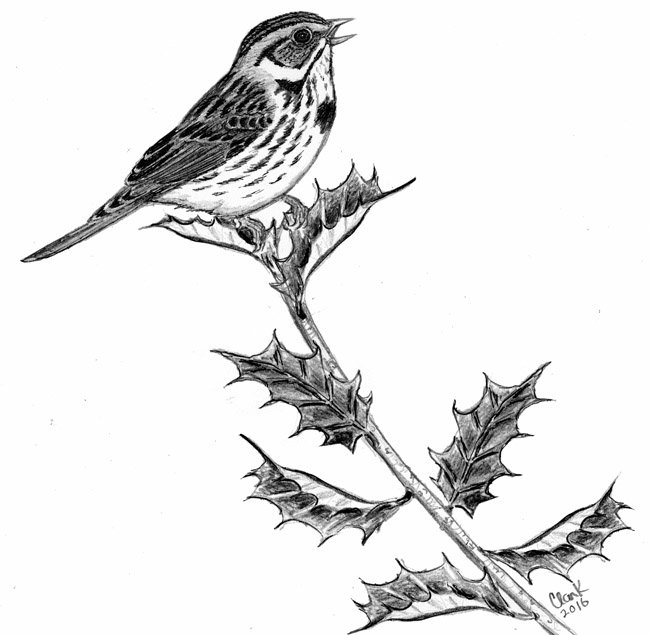
Dear Bird Folks,
Last week I visited your shop and played a recording of a bird that has been singing in my yard all summer. You told me that the bird was a Song Sparrow. However, when I got back home and listened to Song Sparrows on my birdsong CDs, they sounded different from my mystery bird. Are you sure about your Song Sparrow conclusion?
– Burt, Falmouth, MA
Come on, Burt,
You are the last person on earth still using CDs and you doubt my judgment? I’ll bet your TV has rabbit ears. Am I right? Oh, I’m just teasing. Actually, sometimes I wish my TV still had rabbit ears because my monthly cable bill is higher than my mortgage. But take it from a guy who sells birdsong CDs for a living, smartphone apps are a better way to go. Apps are cheaper and contain thousands of songs that can be located and played instantly. As much as I hate losing CD sales, I suggest you download one of those bird apps onto your cell phone. Unless, of course, the phone you use has a rotary dial on it. In that case, I give up.
For many novice birders, identifying dull brown sparrows is so frustrating that they just call them LBJs (little brown jobs) and are done with it. But I take a different approach. I assume every sparrow I see is a Song Sparrow because Song Sparrows are ubiquitous in Massachusetts. They are common in backyards as well as woodlands, fields and along marshes. Unless the bird has some obvious field mark (i.e., white throat, white crown or rufous cap), it’s probably a Song Sparrow (at least in my mind). Right now you are thinking that my lazy approach to sparrow identification is the reason I called your mystery bird a Song Sparrow without giving it much thought. No, the reason I said your bird was a Song Sparrow is because that’s what it is. Really.
As their name implies, Song Sparrows are mastersingers. Their songs can be heard spring, summer, fall and even in the winter…and at night. Most other birds tend to sing early in the morning, but Song Sparrows will sing anytime of day. When the male sparrow is in the mood to belt out a song, he will fly to a treetop, or fence post, or some other prominent location and let loose. As I write this, I’m hearing a couple of different Song Sparrows singing in my yard (this is the part that relates to your question, Burt) and none of them sound the same. That’s just the way they are.
Some birds attract their mates with ornate plumes (peacocks), while others use showy aerial displays (hummingbirds); but with Song Sparrows it’s all about vocal skills. The birds with the finest songs have the best chance of attracting a mate. Song Sparrows’ songs are variable, but not in an extreme sense. It’s not as if they sing like a bobwhite one minute, a loon the next and then do a quick Henny Youngman impression. Their variations have to do with intensity, length of trills, or the number of introductory notes. What causes these differences, you ask? (I doubt you actually care, but I’m going to tell you anyway.)
Age is one factor. The males simply get better as they get older. (That sure hasn’t happened to me.) Geography also has an influence. As with human speech, birds sound differently in different locations. I doubt the birds on your CD (CD? Seriously?) were recorded in Falmouth. Cape Cod birds sound different than the birds that are in, say, Iowa. (Probably from too much corn in their diet.)
The next question is: If two of these birds don’t necessarily sing alike, how can I be so sure the bird you recorded is, in fact, a Song Sparrow? As I mentioned, Song Sparrows are found everywhere in Massachusetts. It’s hard to go for a walk without hearing one, or two or five. Over the years I’ve simply gotten familiar with the Song Sparrow’s “voice” and can recognize it no matter what notes it is singing. It’s much in the same way that I can hear my wife telling me what to do, even if we are in a crowded room. Although truth be told, I can hear her voice telling me what to do even if she’s not in the same room, or even in the same town. Birdcall apps (or CDs or 8-tracks) are okay to use Burt, but the absolute best way to learn your bird songs is to go outside and see the bird while it is singing. I find watching a bird in the act of singing really helps me to remember it later. I think you should try that. If it doesn’t help, just make another recording and I’ll identify it for you again. I’m good either way.
On a different topic:
For the past few weeks I’ve received a number of calls from people whose bird feeders have been quiet. I’ve written about the dreaded no-bird syndrome plenty of times, but never in mid-summer when hungry baby birds are everywhere. At first I was puzzled, but I quickly discovered that all of the “no bird” people had one thing in common. Their yards have been denuded (I hope it’s okay to write “denuded” in the newspaper) by the recent gypsy moth outbreak. Without foliage for protection from the heat and predators, the birds may have simply moved to a more shady part of town. Hopefully, as the trees generate new leaves, the birds will return. In the meantime, anyone who wants to see birds can come to my yard. I have plenty. There has been no denuding in my neighborhood, which is a good thing considering the age of my neighbors.